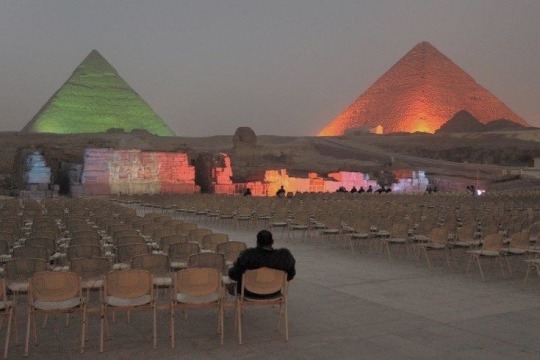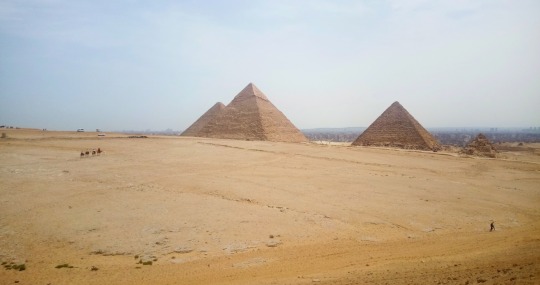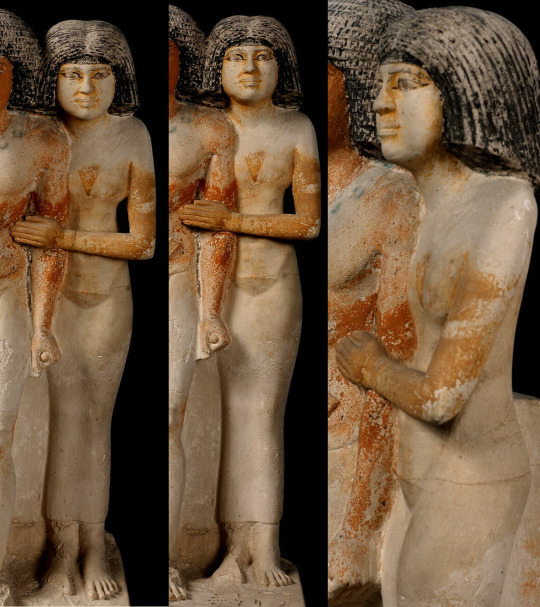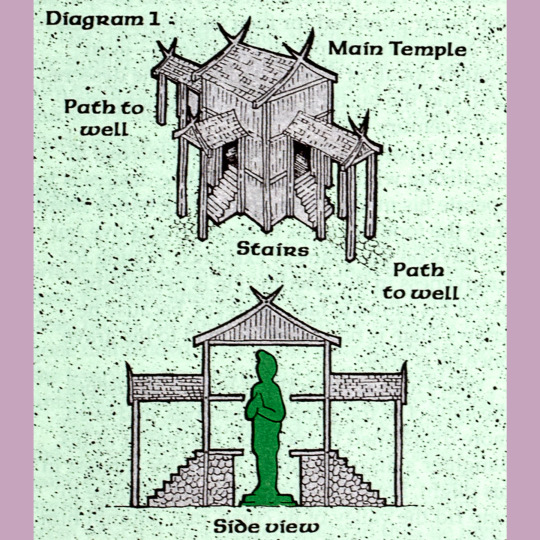#giza necropolis
Explore tagged Tumblr posts
Text

#pyramids#pyramid#ancient egypt#old civilizations#monument#egypt#polyhedron#polygonal#Giza Necropolis#Pyramids of the Giza Necropolis.#Giza pyramid complex
42 notes
·
View notes
Text
Sold Out event for Ka, Ba and Akh reunions at the Giza necropolis

1K notes
·
View notes
Text

Sphynx et grande Pyramide de Gizeh, Basse Egypte. The Great Pyramid and the Great Sphinx of Giza , Greater Cairo, Egypt photographed By Christophe Ma��trejean.
#photographers on tumblr#egypte#pyramide#gizeh#ancient egypt#grande pyramide#sphynx#history#Giza necropolis#Pyramid of Cheops
1 note
·
View note
Text






Pyramid of Unas, Saqqara
29 notes
·
View notes
Text

Giza Pyramids, Egypt. Photographed by Christophe Maîtrejean
All three of Giza's famed pyramids and their elaborate burial complexes were built during a frenetic period of construction, from roughly 2550 to 2490 B.C. The pyramids were built by Pharaohs Khufu (tallest), Khafre (background), and Menkaure (right).
#photographers on tumblr#egypte#pyramids of giza#funeral art#taphophilia#grave#art funeraire#giseh#necropolis#ancient egypt#landscape#egypt
21 notes
·
View notes
Text

Gala Dinner Experience
Indulge in a Gala Dinner Experience with Savvy Travelers, savoring exquisite cuisine and entertainment!
#egypt nile river cruise#egypt nile cruise#luxurious nile cruise#nile river cruise#cairo exploration tour#pyramids giza visit#valley kings excursion#egyptian museum tour#alabaster mosque visit#sakkara necropolis tour#mena house experience#hatshepsut temple exploration#colossi memnon sightseeing#edfu temple discovery#aswan felucca ride#abu simbel excursion#cataract hotel tea#philae temple visit#nubian village tour#kom ombo visit#karnak temple exploration#luxor market shopping#hathor temple tour#dendara temple visit#abdeen palace tour#coptic cairo exploration#welcome reception cocktail#gala dinner experience#egyptologist guided tour#exclusive shore excursions
0 notes
Text

Couple Statue - Louvre Collection
Photo Focus: Meresankh Main number: E 15592 Other inventory number: E 22769 Old Kingdom, 5th dynasty (attribution according to style) (-2500 - -2365) Location Information: Giza (Memphite Necropolis->Memphite Region->Lower Egypt) (?)
Description:
Depicts Raherka (dignitary, inspector of scribes); Meresankh (wife). Woman (standing, dress, half-long wig, holding by the shoulder); man (standing, loincloth with rounded edge, arms dangling, short curly wig, ousekh necklace).
#Louvre#Meresankh#E 15592#E 22769#Old Kingdom#Dynasty 5#couple statue#womens clothing#okwc#giza#memphite region#memphite necropolis#lower egypt
1 note
·
View note
Text
New update!
The entirety of Weeping Gods Chapter 4 is live now 🥳
Again, like every other times, this is not the final version of the chapter (or the game). There will likely be many edits and fixes later because the entire game is under development.
All saves are going to break because there are many new variables added.
Also! 😲 Weeping Gods is now hitting 500 000 words! I am truly, completely astonished. I have never written this much for one project before. Ever. It's a giant achievement. Half a million words is an enormous amount.
What's new in this update:
The entire Chapter 4 is added to the game. It's about 157 000 words. I also recalculated the average playthrough of the game, and now it hits around 80 000 words
Your group steps on the journey to Memphis to recover the missing artifacts
You get to reevaluate the fallout with Narmer
You will meet 2 new characters and get an extra weapon from one of them
You can see a random encounter scene on the road. Currently, there are only 2 variations, but I'm going to add more later
Spend a day in the new royal capital with your favorite companion
Visit the market and buy STUFF
Visit the Giza Necropolis and have an adventure inside the Great Pyramid of Giza
And after everything is said and done... learn one of the biggest secrets that your group has been keeping from you
I hope you will enjoy it! ❤️
LINK
JC
298 notes
·
View notes
Text

Serving statuette of a woman grinding grain
Egyptian tombs sometimes contained small figures showing people engaged in ordinary, domestic tasks such as baking, weaving, brewing and so forth. Such statues, known as serving statues, were included in the tomb to ensure that the deceased would enjoy the benefits of the products and services represented. Additionally, servant statues communicate a great deal about Egyptian daily life.
This limestone figure shows a woman grinding corn. She wears a cloth over her woman's wig to keep the flour out of her hair. Grain waiting to be ground sits in a heap at the head of the grinding stone while the flour forms a little pile at the base.
Old Kingdom, 5th Dynasty, reign of Nyuserre, ca. 2465-2323 BC. From Giza necropolis. Now in the MFA, Boston. 21.2601
208 notes
·
View notes
Text
guinefort was a dog who was sainted in 13th century france.
laika was a dog sent into space by the soviet space program in the 1950s, the first animal in orbit.
margarita (meaning: pearl) was a pet in roman gaul and had an elaborate epitaph and mosaic on her grave site.
abuwtiyuw is the oldest known named dog, and was buried and honored at the giza necropolis.
diogenes was a greek philosopher of the cynical school. get it.
i'm really curious whether anyone has heard of a couple of these bc they are everything to me (<- archaeology student) so let me know in the tags if you know of them or don't, where you learned about them, etc. and please reblog <3
#this idea came to me in the night idk.#dog#polls#tumblr polls#pls reblog for reach#i would've added the doggy from pompeii but i can't bear to think about them for too long or i start crying...
34 notes
·
View notes
Text


Great Sphinx and Giza Necropolis, Al Haram, Egypt
#MINE#photography#goddamn it was so hot#but so cool#egypt#ancient egypt#travel photography#film photography#film#my photography#lensblr#wanderlust#original photography#photographers on tumblr
7 notes
·
View notes
Text






Country Sites (1995) is the last of the site series of sourcebooks (another was planned — Planar Sites, but that turned into Vortex of Madness a couple years later). This is better than Castle Sites but a tiny bit inferior to City Sites, I think? It’s close. The upshot is that this is a book full of high quality material that is just shy of system agnostic, and thus a resource for all sort of RPGs.
There are two sorts of site here, minor and major. All of them include maps, history, NPCs and other necessary information. The minor sites are a bridge over a gorge, a fort, a toll house and a riverside inn. They are brisk little things, peppered with adventure seeds.
The major sites are more like short, open-ended adventures. There’s a haunted temple, a tent city in the caldera of a dormant volcano (is it a caldera if it is dry? I dunno, but this is not a lake), a necropolis, a floating ship’s graveyard (not unlike Hodgson’s Sargasso stories), an island prison, a big old wall and a bizarre castle. A couple of these are immediately identifiable riffs on real-world locations — the last seems like Bavaria’s Neuschwanstein, the wall is obviously Hadrian’s, the necropolis draws from the mastaba tombs surrounding the pyramids of Giza, the prison echoes Alcatraz. These all boast quite a bit more material. The ship’s graveyard seems particularly robust, with ten separate ships detailed (though no seaweed people, alas). I like pretty much all of this stuff, but I like it slightly less for those real world connections. They fix them in my mind in a way that is unhelpful and a bit prosaic. I expect that is my own damn problem, though.
Excellent illustrations throughout by Phillip Robb. Dennis Kauth did all the cartography, which is a clear selling point of the book and does much to evoke the site. I love Jennell Jaquays’ cover here, too. This one feels almost Games Workshoppish.
104 notes
·
View notes
Text

The Great Pyramid of Menkaure (Completed i 2510 BCE) and Queen's pyramid.
The Giza Necropolis
Cairo, Egypt 2024
#pyramids#desert;#egypt#giza#photobythomas#original photographers#photographers on tumblr#photography
10 notes
·
View notes
Text
Archaeologists have launched a huge project to restore the smallest of Giza's three famous pyramids to what they believe it looked like when it was built more than 4,000 years ago. An Egyptian-Japanese archaeological mission announced the project to put back in place hundreds of granite blocks that used to form the outer casing of the pyramid of King Menkaure, the smallest of the three main pyramids on the iconic Giza Necropolis.
9 notes
·
View notes
Text
I’d love to visit the Giza Necropolis sometime.
2 notes
·
View notes
